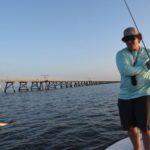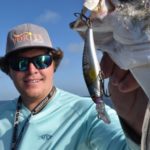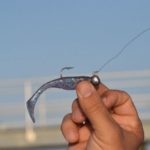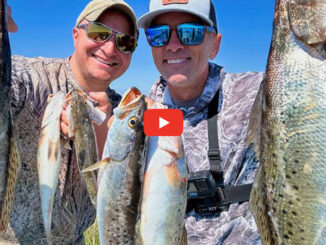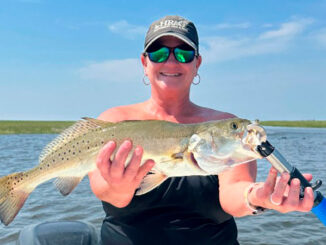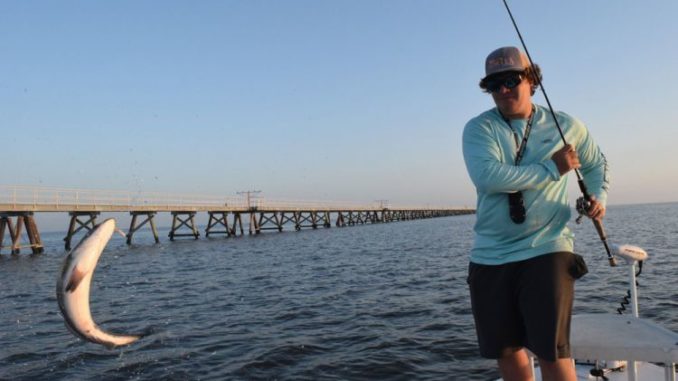
Putting in some time on the computer before you hit the water could pay off big — if you can locate underwater reefs, shell pads and pilings in Lake Pontchartrain. One guide shares some tips that will help you catch more trout.
Homework and studying are some of the biggest complaints from high school and college students. They go to class all day, then come home and have to hit the books again.
Being a part-time student at the University of New Orleans, Capt. Ty Hibbs is certainly no stranger to homework.
But some studying Hibbs doesn’t dread is researching the south shore of Lake Pontchartrain. This time of year, he usually finds piles of speckled trout on reefs there.
“What I do is find all the old shell pads and pilings in the lake,” he said. “You’ve got to do a little bit of research and work.”
Hibbs does his research on a website called Sonris, using his computer at home before a trip. But the website isn’t exactly a cakewalk to use.
“Look up a tutorial on YouTube, and it’ll show you more on how to use it,” he said. “It’ll tell you where the old shell pads were.
“It’ll tell you anything that was one time a danger to maritime traffic — wellheads, pilings, everything.”
The homework Hibbs does is ultra-beneficial when it comes to trying to locate the reefs, which is oftentimes the most difficult part. But research alone isn’t enough to locate and fish the reefs effectively.
“You have to learn how to read your sonar,” Hibbs said. “If you’re just using your sonar and you have no idea what’s what on there, it’s no help.”
It’s all about quality – not quantity
The great thing about fishing these reefs is there’s little boat pressure simply because anglers have to put in so much time to find them, and most people want to be given an “X marks the spot” location.
Another good aspect about putting in time to find the reefs — other than serenity on the water — is the size of the fish. Hibbs hasn’t caught any 9-pounders yet, but he has noticed better-than-average fish.
“I’ve seen some really nice fish come off the reefs,” he said. “I’ve caught some good 3- and 4-pound fish off them.
“I’ve heard of people catching 5- and 6-pounders off them still to this day.”
He advised quality-minded anglers not to pass up the south shore reefs.
“Usually, they’re some nicer fish,” he said. “We don’t catch a lot of those smaller fish for some odd reason. You’re not fishing around the south shore for numbers; you’re fishing for size.”
If anglers don’t want to go through the rigorous process of finding reefs no longer than one boat length in a wide open Lake Pontchartrain, Hibbs said locating reef balls is a great alternative.
“They’re pretty obvious (to find),” he said. “They’re all marked. You can just type in ‘Lake Pontchartrain reef balls’ and you can find the coordinates of them.”
But before he even thinks about going to fish the reefs in the spring, Hibbs looks for a specific weather condition that tells him the fish are out there.
“The springtime is really dependent on southeast winds,” he said, noting it also brings salty water into the lake. “The southeast wind keeps it from getting too rough on the south shore.”
Once he pulls up to the reef, the young captain puts his trolling motor to work, rather than dropping down a big hunk of steel.
“I hardly ever anchor,” he said. “I have an iPilot, so if I ever anchor, I’ll just press anchor mode on it.”
Minn Kota’s iPilot has what the company calls a Spotlock feature that keeps you in the same location, no matter the wind or tide. It’s an invaluable tool for keeping you on top of a small reef.
Deepwater jigging is key
Although Hibbs does about 50 trips a year where he takes clients shallow-water redfishing, his true passion is jigging Lake Pontchartrain with plastic. But Hibbs said live shrimp is definitely a viable option on the reefs.
“If you’re going to fish live bait on those reefs, anchor upcurrent from it, and let your bait drift over the reef,” he advised.
Hibbs would rather get a root canal than fish the live stuff, so he’s always got a jigging rod in his hand, and he casts at a different angle than the guys fishing live bait.
“If you’re going to jig it, anchor downcurrent and cast into it,” he said.
Fishing around the reefs means jigging a lot of deep water, according to Hibbs.
“Most of the time around the reefs, it’s 15 to 17 feet of water,” he said. “As you get toward those reef balls and some of the shell pads, they’re a little bit shallower — 10, 11, 12 feet deep.”
To get the jig down to the bottom, Hibbs almost always throws a 3/8-ounce GoldenEye jighead, but he said he’ll go heaver if he needs to.
“If it’s really rocking current somewhere, I’ll throw a ½-ounce, but the lighter the better,” he said. “The fish won’t feel it as much.
“If it’s slick calm and there’s no tide, you can get away with a 5/16-ounce, but that’s really tough to feel — more advanced stuff.”
Hiibs said no matter the size of the jighead you’re using, it’s important to bring an ample supply of them.
“You’re going to snag up a lot,” he said. “It’s all part of the game. If you’re getting snagged, you’re in the right area.
“It’s not a bad thing.”
When the inevitable does happen, Hibbs doesn’t just leave his 50-cent jighead down at the bottom without it benefiting him.
“When you snag onto the reef, don’t just pop it off,” he said. “Cut it right at the surface, and tie a cork to it.
“That’s going to be a perfect marker buoy.”
Like most things in life, fishing the Lake Pontchartrain reefs is much easier to do without wind because the actual reef and the bait around it is easier to spot.
“If it’s calm, you’ll actually see the tide ripping across the top of the (reef),” he said. “You’ll see a little wind ripple, and there will be a slick right over the reef, and you’ll see some glass minnows over the top.”
Although lack of tidal movement isn’t a deal-breaker for Hibbs, he said it’s always advantageous to have some moving water.
“We don’t see a drastic tide out here, but tide always helps in the lake,” he said. “We’re not as tide-dependent as we used to be, though. I feel like years ago when we caught some bigger fish, it was a lot more tide dependent.
“Now, if it’s doing anything, I like it. If it’s not, I’m still going fishing.”
Generally, if it either has been calm or blowing southeast for a few days, the water clarity will be superb. In this situation, Hibbs likes natural-colored lures: His favorites are holy joely and shrimp creole-colored Matrix Shad.
However, when he’s faced with dirtier water, Hibbs likes Spartacus and purple-haze-colored Vortex Shad.
